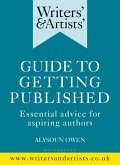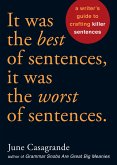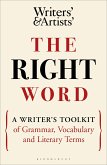Sara Grant
The Ultimate Guide to Editing Your Novel
A Revolutionary Approach to Transform Your Writing
Sara Grant
The Ultimate Guide to Editing Your Novel
A Revolutionary Approach to Transform Your Writing
- Broschiertes Buch
- Merkliste
- Auf die Merkliste
- Bewerten Bewerten
- Teilen
- Produkt teilen
- Produkterinnerung
- Produkterinnerung
A Novel Approach to Editing
Andere Kunden interessierten sich auch für
![Children's Writers' & Artists' Yearbook 2026 Children's Writers' & Artists' Yearbook 2026]() Children's Writers' & Artists' Yearbook 202636,99 €
Children's Writers' & Artists' Yearbook 202636,99 €![Writers' & Artists' Guide to Self-Publishing Writers' & Artists' Guide to Self-Publishing]() Writers' & Artists' Guide to Self-Publishing23,99 €
Writers' & Artists' Guide to Self-Publishing23,99 €![Writers' & Artists' Guide to How to Write Writers' & Artists' Guide to How to Write]() William RyanWriters' & Artists' Guide to How to Write23,99 €
William RyanWriters' & Artists' Guide to How to Write23,99 €![Writers' & Artists' Guide to Getting Published Writers' & Artists' Guide to Getting Published]() Writers' & Artists' Guide to Getting Published23,99 €
Writers' & Artists' Guide to Getting Published23,99 €![Writers' & Artists' Guide to How to Hook an Agent Writers' & Artists' Guide to How to Hook an Agent]() James RennoldsonWriters' & Artists' Guide to How to Hook an Agent24,99 €
James RennoldsonWriters' & Artists' Guide to How to Hook an Agent24,99 €![It Was the Best of Sentences, It Was the Worst of Sentences It Was the Best of Sentences, It Was the Worst of Sentences]() June CasagrandeIt Was the Best of Sentences, It Was the Worst of Sentences12,99 €
June CasagrandeIt Was the Best of Sentences, It Was the Worst of Sentences12,99 €![The Right Word The Right Word]() The Right Word19,99 €
The Right Word19,99 €-
-
-
Produktdetails
- Produktdetails
- Writers' and Artists'
- Verlag: Bloomsbury Publishing PLC
- Seitenzahl: 272
- Erscheinungstermin: 27. Juni 2025
- Englisch
- Abmessung: 206mm x 151mm x 22mm
- Gewicht: 304g
- ISBN-13: 9781399418867
- ISBN-10: 1399418866
- Artikelnr.: 73582553
- Herstellerkennzeichnung
- Libri GmbH
- Europaallee 1
- 36244 Bad Hersfeld
- gpsr@libri.de
- Writers' and Artists'
- Verlag: Bloomsbury Publishing PLC
- Seitenzahl: 272
- Erscheinungstermin: 27. Juni 2025
- Englisch
- Abmessung: 206mm x 151mm x 22mm
- Gewicht: 304g
- ISBN-13: 9781399418867
- ISBN-10: 1399418866
- Artikelnr.: 73582553
- Herstellerkennzeichnung
- Libri GmbH
- Europaallee 1
- 36244 Bad Hersfeld
- gpsr@libri.de
Sara Grant
Contents Introduction How to use this book Chapter 1: Interrogating your idea Remain true to your vision
Read for inspiration
Big picture analysis
Write your pitch
The responsibility of writing for children Chapter 2: Character by character Interrogating your protagonist
Secondary character examination
Character continuum
Tangled characters Chapter 3: Finding the plot Structural edit
What is plot?
Solutions to your plot problems
Tackling your theme
Managing the middle
Plot formulas Chapter 4: Chapter by chapter Conscious creation
Structure
Taking inventory
For inspiration
Checklist Chapter 5: Scene by scene Identifying a scene
Breathing life into a scene
Setting and atmosphere
Checklist Chapter 6: Honing voice What is voice?
Point of view
Present or past tense?
Excavating voice
Enhancing your voice Chapter 7: Writing with sensitivity Tough questions
Dos and don'ts
Think big, think small
Checklist Chapter 8: Sentence by sentence Examining each sentence
Discovering how you tell a story
Checklist Chapter 9: Word by word Word choice
Tighten your writing
Checklist Chapter 10: Beginnings and endings Hooking readers from the opening pages
Evolution of an opening
Prologues
The end
Epilogue Chapter 11: The final polish Crafting the perfect title
Final check
Line editing and proofreading
The final proofread
When to stop Chapter 12: Ready for the world Why you need an agent
Choosing an agent or editor
Preparing your submissions packet
Never give up! Resources and references Acknowledgements Author biography Index
Read for inspiration
Big picture analysis
Write your pitch
The responsibility of writing for children Chapter 2: Character by character Interrogating your protagonist
Secondary character examination
Character continuum
Tangled characters Chapter 3: Finding the plot Structural edit
What is plot?
Solutions to your plot problems
Tackling your theme
Managing the middle
Plot formulas Chapter 4: Chapter by chapter Conscious creation
Structure
Taking inventory
For inspiration
Checklist Chapter 5: Scene by scene Identifying a scene
Breathing life into a scene
Setting and atmosphere
Checklist Chapter 6: Honing voice What is voice?
Point of view
Present or past tense?
Excavating voice
Enhancing your voice Chapter 7: Writing with sensitivity Tough questions
Dos and don'ts
Think big, think small
Checklist Chapter 8: Sentence by sentence Examining each sentence
Discovering how you tell a story
Checklist Chapter 9: Word by word Word choice
Tighten your writing
Checklist Chapter 10: Beginnings and endings Hooking readers from the opening pages
Evolution of an opening
Prologues
The end
Epilogue Chapter 11: The final polish Crafting the perfect title
Final check
Line editing and proofreading
The final proofread
When to stop Chapter 12: Ready for the world Why you need an agent
Choosing an agent or editor
Preparing your submissions packet
Never give up! Resources and references Acknowledgements Author biography Index
Contents Introduction How to use this book Chapter 1: Interrogating your idea Remain true to your vision
Read for inspiration
Big picture analysis
Write your pitch
The responsibility of writing for children Chapter 2: Character by character Interrogating your protagonist
Secondary character examination
Character continuum
Tangled characters Chapter 3: Finding the plot Structural edit
What is plot?
Solutions to your plot problems
Tackling your theme
Managing the middle
Plot formulas Chapter 4: Chapter by chapter Conscious creation
Structure
Taking inventory
For inspiration
Checklist Chapter 5: Scene by scene Identifying a scene
Breathing life into a scene
Setting and atmosphere
Checklist Chapter 6: Honing voice What is voice?
Point of view
Present or past tense?
Excavating voice
Enhancing your voice Chapter 7: Writing with sensitivity Tough questions
Dos and don'ts
Think big, think small
Checklist Chapter 8: Sentence by sentence Examining each sentence
Discovering how you tell a story
Checklist Chapter 9: Word by word Word choice
Tighten your writing
Checklist Chapter 10: Beginnings and endings Hooking readers from the opening pages
Evolution of an opening
Prologues
The end
Epilogue Chapter 11: The final polish Crafting the perfect title
Final check
Line editing and proofreading
The final proofread
When to stop Chapter 12: Ready for the world Why you need an agent
Choosing an agent or editor
Preparing your submissions packet
Never give up! Resources and references Acknowledgements Author biography Index
Read for inspiration
Big picture analysis
Write your pitch
The responsibility of writing for children Chapter 2: Character by character Interrogating your protagonist
Secondary character examination
Character continuum
Tangled characters Chapter 3: Finding the plot Structural edit
What is plot?
Solutions to your plot problems
Tackling your theme
Managing the middle
Plot formulas Chapter 4: Chapter by chapter Conscious creation
Structure
Taking inventory
For inspiration
Checklist Chapter 5: Scene by scene Identifying a scene
Breathing life into a scene
Setting and atmosphere
Checklist Chapter 6: Honing voice What is voice?
Point of view
Present or past tense?
Excavating voice
Enhancing your voice Chapter 7: Writing with sensitivity Tough questions
Dos and don'ts
Think big, think small
Checklist Chapter 8: Sentence by sentence Examining each sentence
Discovering how you tell a story
Checklist Chapter 9: Word by word Word choice
Tighten your writing
Checklist Chapter 10: Beginnings and endings Hooking readers from the opening pages
Evolution of an opening
Prologues
The end
Epilogue Chapter 11: The final polish Crafting the perfect title
Final check
Line editing and proofreading
The final proofread
When to stop Chapter 12: Ready for the world Why you need an agent
Choosing an agent or editor
Preparing your submissions packet
Never give up! Resources and references Acknowledgements Author biography Index








